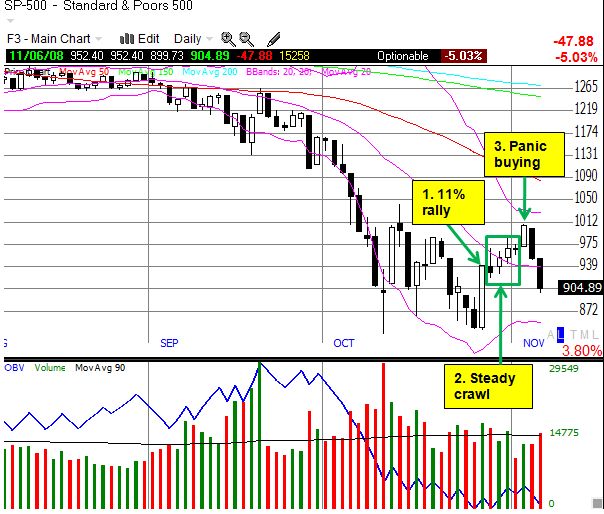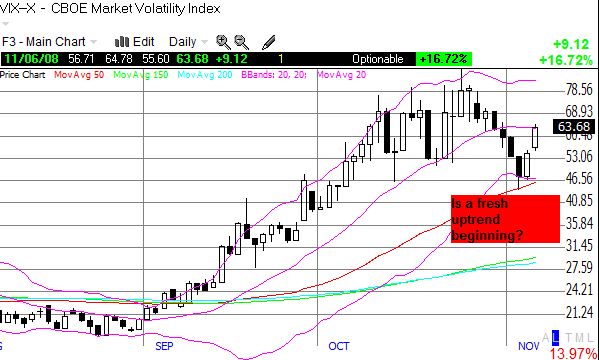Share Click here to suggest a topic using Skribit. Search past articles here.
The market failed the test at its critical juncture in dramatic fashion. As I stated Tuesday night, a market reversal and bounce in volatility was the most likely scenario following the election just based on technical indicators. The last leg of this scenario is a near, if not complete, rollback of the V-bounce. If the jobs number Friday morning is something horrific, we will most likely get that reversal. We are "only" another 6.2% drop away - the market's stubbornly high levels of volatility (the VIX) warn us that such a large one-day move is well within the realm of possibilities. Indeed, the last two trading days have featured sell-offs over 5% each.
Looking back at the chart of the S&P 500, I now want to make a quick case that what we saw was the classic anatomy of panic buying, the kind of sharp and sudden bursts so often found in the middle of bear markets. The panic buying unfolded in three stages shown in the chart below.

- On October 28, the S&P 500 rallied an incredible 11%. I struggled to understand the litany of reasons offered for the move, but they do not matter. What matters more for this story is that the S&P 500 rallied a similar amount just two weeks prior only to rollback the entire move in just two days. So the stage was set for a tension between the buyers who felt that "this time is different" and the sellers who are eager for reasons to just get out of this bear market.
- I describe the next four days as a "steady crawl." The first day featured a day very similar to what happened two weeks prior: a slightly lower open, a small rally, and then a lower close. Bears were likely gearing up for another fade. But instead of a fade, we closed out October with two up days - something we had not seen for an entire month. Bears get nervous and buyers get motivated. The final day of the crawl was a stalemate that was a perfect collector of tension looking for a reason to break sharply either up or down. The election gave the perfect "excuse" for action: I heard a few pundits rationalize the move as jubilation over the resolution electoral uncertainty.
- After almost two months of non-stop selling, we finally printed a string of trading days that looked different: the S&P 500 was up 14% over a 5-day stretch and volatility was actually down for three straight days. With an election the next day riding on polls that showed a clear victory for Obama, we had all the sparks we needed for some panic buying. On November 3, we got a 4% up day featuring nearly non-stop buying. Bears had to rush for cover and buyers rushed in fearing they would miss out on whatever happy news the market was anticipating. Moreover, no one wanted to let the market leave behind "the bottom" without them - even if it meant buying right at stiff technical resistance under overbought conditions.
Repeating from my last piece, the key going forward is how the market handles this rollback of the V-bounce. So far, I am not seeing the orderly correction I wanted. Sure, volume has not surged on the selling, but volatility has bounced sharply and has decisively broken its short-term downtrend. It even bounced in picture-perfect fashion off of the 50DMA (see chart below). It is starting to seem like we need yet another violation of the lows to clear the way for stronger hands (if any are still out there!). I am almost certain that every technical trader worth his/her salt is looking to fade whatever the reaction is to Friday's jobs report. We also have Obama's first press conference as president-elect to further cloud and frustrate any attempt to assess cause and effect. So, look to next week for clearer clues as to whether the market wants to hold the current lows.

One last note on volatility. A lot of fuss has been made about Warren Buffett's selling of puts on Burlington Northern (BNI) - the mere knowledge of this news is likely to "pin" BNI in the $73-80 range until these puts expire in December. I think this is a great approach for bidding on stock you already want to own since you collect premium on top of the price at which you are willing to buy the stock. These premiums are especially high right now. But it is dangerous to assume that because Buffett is selling puts, you can extend this strategy into generalized, speculative put-selling. If you are not yet convinced that we are having a Black Swan kind of year, you have not been paying attention to all of the unprecedented and historic action. These conditions strongly favor put (or even call) buyers, not sellers (although risk/reward does diminsh as volatility skyrockets). As long as volatility remains high, and especially if it is trending higher, you have to continue to expect the unexpected - be prepared and capitalized to own your speculation under "worst-case" scenarios. You can be sure Buffett has the cash to buy all the BNI he has leveraged into. Most of us are not Buffett.
Be careful out there!
Full disclosure: Long S&P 500 in an index mutual fund. For other disclaimers click here.
Share